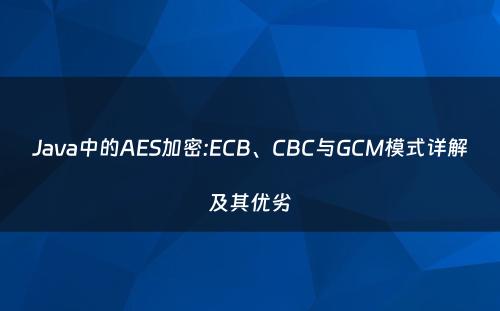网站首页 > java教程 正文
AES(Advanced Encryption Standard)是一种广泛使用的对称加密算法,它提供了多种工作模式,如ECB(Electronic Codebook)、CBC(Cipher Block Chaining)和GCM(Galois/Counter Mode)。每种模式都有其特定的用途和优缺点。本文将详细讨论这些模式,以及如何在Java中实现AES加解密,同时分析它们的适用场景和注意事项。
1. ECB模式
原理

ECB是最基础的加密模式,它将数据分为128位的块独立加密,不考虑相邻块之间的关系。
优缺点
- 优点:简单快速,易于实现。
- 缺点:不安全,相同的明文块将产生相同的密文块,容易被模式分析攻击。
示例代码
import javax.crypto.Cipher;
import javax.crypto.spec.SecretKeySpec;
import java.util.Base64;
public class AESECBExample {
private static final String ALGORITHM = "AES/ECB/PKCS5Padding";
private static final String KEY = "0123456789ABCDEF0123456789ABCDEF";
public static void main(String[] args) throws Exception {
String plainText = "This is a secret message";
byte[] encryptedBytes = encrypt(plainText, KEY);
System.out.println("Encrypted (Base64): " + Base64.getEncoder().encodeToString(encryptedBytes));
byte[] decryptedBytes = decrypt(encryptedBase64, KEY);
String decryptedText = new String(decryptedBytes, StandardCharsets.UTF_8);
System.out.println("Decrypted Text: " + decryptedText);
}
// 加密方法
private static byte[] encrypt(String plainText, String key) throws Exception {
SecretKeySpec secretKeySpec = new SecretKeySpec(key.getBytes(), "AES");
Cipher cipher = Cipher.getInstance(ALGORITHM);
cipher.init(Cipher.ENCRYPT_MODE, secretKeySpec);
return cipher.doFinal(plainText.getBytes());
}
// 解密方法
private static byte[] decrypt(String encryptedBase64, String key) throws Exception {
SecretKeySpec secretKeySpec = new SecretKeySpec(key.getBytes(), "AES");
Cipher cipher = Cipher.getInstance(ALGORITHM);
cipher.init(Cipher.DECRYPT_MODE, secretKeySpec);
return cipher.doFinal(Base64.getDecoder().decode(encryptedBase64));
}
}2. CBC模式
原理
CBC模式通过将每个明文块与前一个密文块异或后再进行加密,增加了安全性。
优缺点
- 优点:安全性优于ECB,相同明文块不会产生相同密文块。
- 缺点:需要额外的初始化向量(IV),且处理速度稍慢。
示例代码
// 省略相同部分,仅展示与ECB不同的地方
private static byte[] encrypt(String plainText, String key) throws Exception {
SecureRandom random = new SecureRandom();
byte[] iv = new byte[16]; // 16-byte IV
random.nextBytes(iv);
SecretKeySpec secretKeySpec = new SecretKeySpec(key.getBytes(), "AES");
Cipher cipher = Cipher.getInstance("AES/CBC/PKCS5Padding");
cipher.init(Cipher.ENCRYPT_MODE, secretKeySpec, new IvParameterSpec(iv));
byte[] encryptedBytes = cipher.doFinal(plainText.getBytes());
return concatArrays(iv, encryptedBytes);
}
private static byte[] decrypt(String encryptedBase64, String key) throws Exception {
byte[] decodedBytes = Base64.getDecoder().decode(encryptedBase64);
byte[] iv = new byte[16];
byte[] encryptedBytes = new byte[decodedBytes.length - iv.length];
System.arraycopy(decodedBytes, 0, iv, 0, iv.length);
System.arraycopy(decodedBytes, iv.length, encryptedBytes, 0, encryptedBytes.length);
SecretKeySpec secretKeySpec = new SecretKeySpec(key.getBytes(), "AES");
Cipher cipher = Cipher.getInstance("AES/CBC/PKCS5Padding");
cipher.init(Cipher.DECRYPT_MODE, secretKeySpec, new IvParameterSpec(iv));
return cipher.doFinal(encryptedBytes);
}
3. GCM模式
原理
GCM模式结合了CTR(Counter)模式的高效性和CBC模式的认证特性,提供了加密和消息认证。
优缺点
- 优点:安全且高效,提供数据完整性和认证。
- 缺点:实现复杂,需要管理非重用的nonce,且对nonce的安全性要求较高。
示例代码
// 省略相同部分,仅展示与CBC不同的地方
private static byte[] encrypt(String plainText, String key) throws Exception {
SecureRandom random = new SecureRandom();
byte[] nonce = new byte[12]; // 96-bit nonce
random.nextBytes(nonce);
SecretKeySpec secretKeySpec = new SecretKeySpec(key.getBytes(), "AES");
Cipher cipher = Cipher.getInstance("AES/GCM/NoPadding");
GCMParameterSpec gcmSpec = new GCMParameterSpec(128, nonce);
cipher.init(Cipher.ENCRYPT_MODE, secretKeySpec, gcmSpec);
byte[] encryptedBytes = cipher.doFinal(plainText.getBytes());
return concatArrays(nonce, encryptedBytes);
}
private static byte[] decrypt(String encryptedBase64, String key) throws Exception {
byte[] decodedBytes = Base64.getDecoder().decode(encryptedBase64);
byte[] nonce = new byte[12];
byte[] encryptedBytes = new byte[decodedBytes.length - nonce.length];
System.arraycopy(decodedBytes, 0, nonce, 0, nonce.length);
System.arraycopy(decodedBytes, nonce.length, encryptedBytes, 0, encryptedBytes.length);
SecretKeySpec secretKeySpec = new SecretKeySpec(key.getBytes(), "AES");
Cipher cipher = Cipher.getInstance("AES/GCM/NoPadding");
GCMParameterSpec gcmSpec = new GCMParameterSpec(128, nonce);
cipher.init(Cipher.DECRYPT_MODE, secretKeySpec, gcmSpec);
return cipher.doFinal(encryptedBytes);
}
4. 注意事项
- 密钥管理:确保密钥的安全存储和传输,避免密钥泄露。
- 填充模式:在处理非128位整数倍的数据时,需要选择合适的填充模式,如PKCS7、ISO 10126等。
- 随机性:对于CBC和GCM,确保生成的nonce是随机且唯一的。
- 安全性:在可能的情况下,优先选择GCM模式,因为它提供了更好的安全性。
通过理解AES的ECB、CBC和GCM模式,我们可以根据具体需求选择合适的加密策略。在实际应用中,根据数据安全性和性能需求选择合适的填充模式,并注意密钥和nonce的管理,以提高系统的安全性。
- 上一篇: Java基础:锁
- 下一篇: Java中的锁是什么意思,有哪些分类?
猜你喜欢
- 2025-03-06 java中的锁及优化机制
- 2025-03-06 阿里Java一面:精通并发?那聊聊AQS框架及锁吧
- 2025-03-06 Java中各种锁的理解
- 2025-03-06 java aes-128-cbc密钥加SHA1PRNG加密,php&nodejs如何生成一样密钥
- 2025-03-06 Java基础——Java多线程(Lock接口详解)
- 2025-03-06 Java实现MD5加盐加密算法
- 2025-03-06 Java 加密解密PowerPoint文档
- 2025-03-06 Java实现数据加密:掌握DES CBC和ECB两种模式
- 2025-03-06 如何正确理解Java领域中锁机制,我们一般需要掌握哪些理论知识?
- 2025-03-06 Java中的锁是什么意思,有哪些分类?
欢迎 你 发表评论:
- 12-26手机内存不足图片(手机内存不足图片怎么办)
- 12-26手机一键变电脑软件叫什么(手机一键变电脑应用)
- 12-26outlook注册验证太难了(outlook注册不了)
- 12-26怎么看主板型号(bios怎么看主板型号)
- 12-26硬盘坏道是什么意思(硬盘有坏道还能用吗)
- 12-26下载的五笔输入法怎么启用(如何下载五笔打字输入法)
- 12-26amd万能显卡驱动(amd显卡驱动说明)
- 12-26正宗笔画输入法官网(正宗笔划输入法)
- 最近发表
- 标签列表
-
- java反编译工具 (77)
- java反射 (57)
- java接口 (61)
- java随机数 (63)
- java7下载 (59)
- java数据结构 (61)
- java 三目运算符 (65)
- java对象转map (63)
- Java继承 (69)
- java字符串替换 (60)
- 快速排序java (59)
- java并发编程 (58)
- java api文档 (60)
- centos安装java (57)
- java调用webservice接口 (61)
- java深拷贝 (61)
- 工厂模式java (59)
- java代理模式 (59)
- java.lang (57)
- java连接mysql数据库 (67)
- java重载 (68)
- java 循环语句 (66)
- java反序列化 (58)
- java时间函数 (60)
- java是值传递还是引用传递 (62)

本文暂时没有评论,来添加一个吧(●'◡'●)